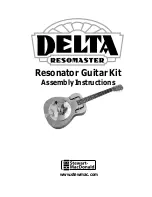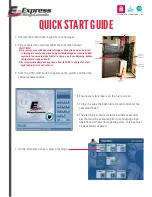
page 10
removing wood from the bottom will lower it. Taking wood
from either side will move the neck in that direction.
It’s important to note that removing wood from the upper
part of the neck cheek edges will not only raise the neck, but
move the neck toward the bridge slightly. If the 12th fret
moves toward the bridge the intonation will be sharp: this is
the reason for checking the neck’s fit before installing the fin-
gerboard.
TIP:
Chisel carefully near the two neck bolts —
don’t push your best chisel toward the bolts!
Remove the last bit of wood around the bolts using
a throw-away item such as a razor knife blade (or
sharpen an old screwdriver to use as a temporary
chisel).
Up until now you have only removed wood from the cheeks
up to the 1/8" remaining “factory edge.”Therefore the neck fit
will be quite close, or even perfect, during this check. Place
the neck into the body with the two mounting bolts through
the neck block holes and press the heel against the body.
Hold the neck in place as you install the two hex nuts; tight-
en them just snug enough to hold the neck. You may need
to move the neck a little.
Don’t use a socket wrench with a right angle drive to tighten
the nuts onto the neck bolts — you could get too much
torque and possibly crack the heel, or pull a bolt out of the
heel!
Instead, make your own nut driver as we did. We made a
long-handled nut driver from a deep-well, square-drive 7/16"
socket, and a #3 Phillips screwdriver which fit the 1/4" drive
perfectly
(19)
. Use a small piece of tape to hold the hex nut
into the socket as you reach into the body to start the nut
onto the bolt. Don’t over-tighten the nuts — the pressure
you can apply with your thumb and fingers should be plenty.
The top surface of the neck (and later, the bottom surface of
the fretboard) will be even with the guitar top when the neck
is bolted on. However don’t look for a flush edge between
the neck and the top because the shaped edge of the metal
rolls off there. Check for flushness about 1/4" back from the
edge instead.
Also, ignore the “dip” in the top in the shoulder area. This will
flatten when it is pulled up to support the fingerboard exten-
sion, which is installed later.
Rest the body, with the neck bolted to it, face up on your
benchtop. The peghead should not contact the table top (so
as not to influence the angle of the neck). Place the cover-
plate into the slightly indented lip around the soundwell
hole and tape it down temporarily.
Use two strong, padded spring clamps to hold the fretted
fingerboard in place on the neck. Place two spacers on the
Neck angle check
19.
A #3 Phillips screwdriver fits the 1/4" square-drive. Use tape to
hold the hex nut into the socket.












































